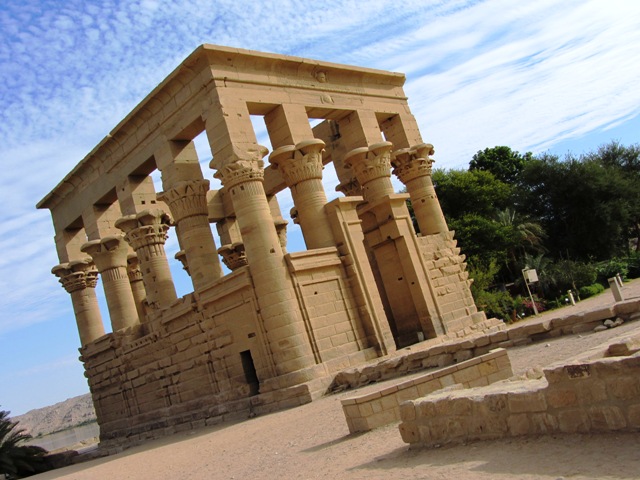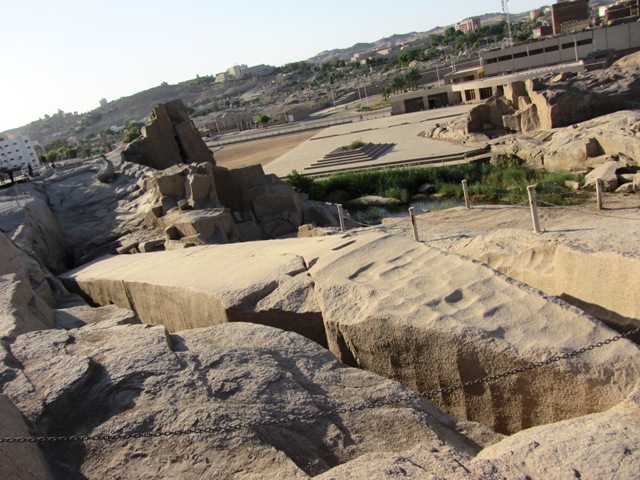Day Excursions
Aswan and the surrounding area is rich with history and boast a number of world famous sites and attractions. Below are a few of the things to see in our area. Our reception staff would be happy to book any excursions for you and your group.
|
Abu Simbel Temples
Wikipedia - The Abu Simbel temples are situated on the western bank of Lake Nasser, about 230 km southwest of Aswan (about 300 km by road). The complex is part of the UNESCO World Heritage Site known as the "Nubian Monuments," which run from Abu Simbel downriver to Philae (near Aswan). The twin temples were originally carved out of the mountainside during the reign of Pharaoh Ramesses II in the 13th century BC, as a lasting monument to himself and his queen Nefertari, to commemorate his alleged victory at the Battle of Kadesh, and to intimidate his Nubian neighbors. However, the complex was relocated in its entirety in 1968, on an artificial hill made from a domed structure, high above the Aswan High Dam reservoir. |
|
Philae Temple
Wikipedia - Philae is an island in Lake Nasser, Egypt. It was formerly an island in the First Cataract of the Nile River and the previous site of an Ancient Egyptian temple complex in southern Egypt. The complex was dismantled and relocated to nearby Agilkia Island during a UNESCO project started because of the construction of the Aswan Dam, after the site was partly flooded by the earlier Aswan Low Dam for half a century. The most conspicuous feature of both islands was their architectural wealth. Monuments of various eras, extending from the Pharaohs to the Caesars, occupy nearly their whole area. The principal structures, however, lay at the south end of the smaller island. The most ancient were the remains of a temple for Isis built in the reign of Nectanebo I during 380-362 BC, was approached from the river through a double colonnade. |
|
Unfinished Obelisk
Wikipedia - The unfinished obelisk is the largest known ancient obelisk. Archaeologists claim the pharaoh known as Hatshepsut sanctioned its construction. It is nearly one third larger than any ancient Egyptian obelisk ever erected. If finished it would have measured around 42 m (approximately 137 feet) and would have weighed nearly 1,200 tons (1,066,621 kilograms). Archeologists speculate that it was intended to complement the so-called Lateran Obelisk which was originally at Karnak and is now outside the Lateran Palace in Rome. (Thutmose III obelisk in Lateran, Rome: 105 ft) Other archaeologists suggest that the pharaoh Hatshepsut ordered it to be built to celebrate her sixteenth year in power. The obelisk's creators began to carve it directly out of bedrock, but cracks appeared in the granite and the project was abandoned. |
|
Felucca Boat Ride
End your day on a felucca boat and enjoy the sunset over the Nile while sipping on warm tea or coffee. Wikipedia - felucca is a traditional wooden sailing boat used in protected waters of the Red Sea and eastern Mediterranean including Malta, and particularly along the Nile in Egypt, Sudan, and also in Iraq. Its rig consists of one or two lateen sails. They are usually able to board ten passengers and the crew consists of two or three people. Despite being made obsolete by motorboats and ferries, feluccas are still in active use as a means of transport in Nile-adjacent cities like Aswan or Luxor. They are especially popular among tourists who can enjoy a quieter and calmer mood than motorboats have to offer. |
Website designed and managed by Social Network Solutions
Your One-Stop Shop for Online Marketing
www.socialnetworksolutions.ca
Your One-Stop Shop for Online Marketing
www.socialnetworksolutions.ca




